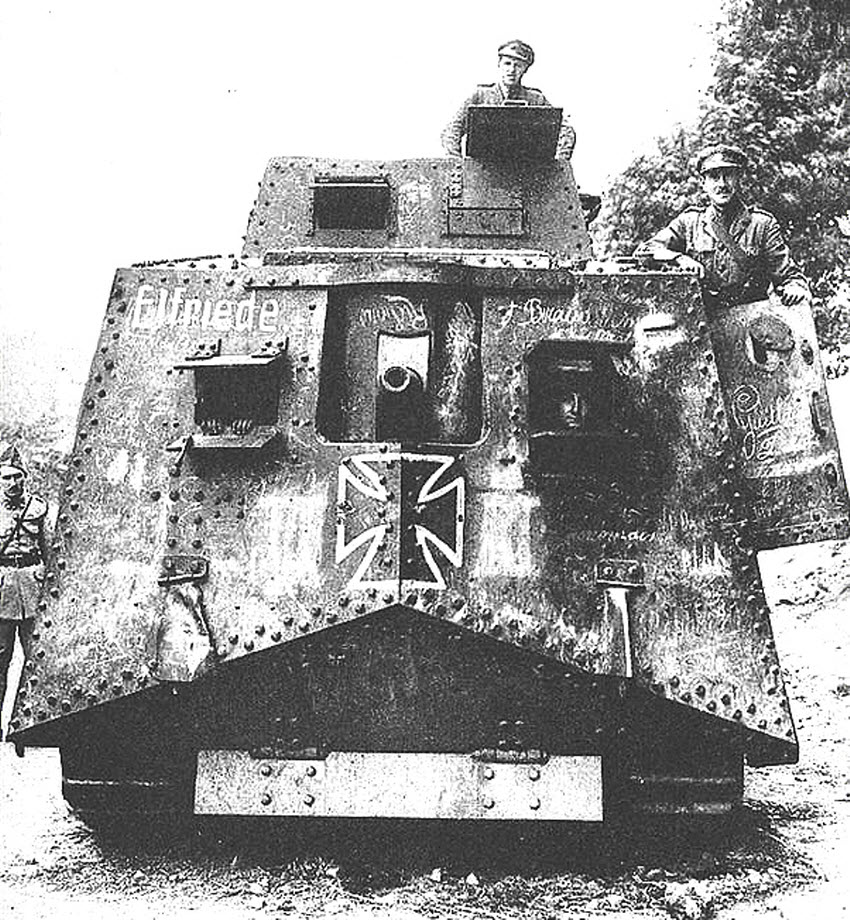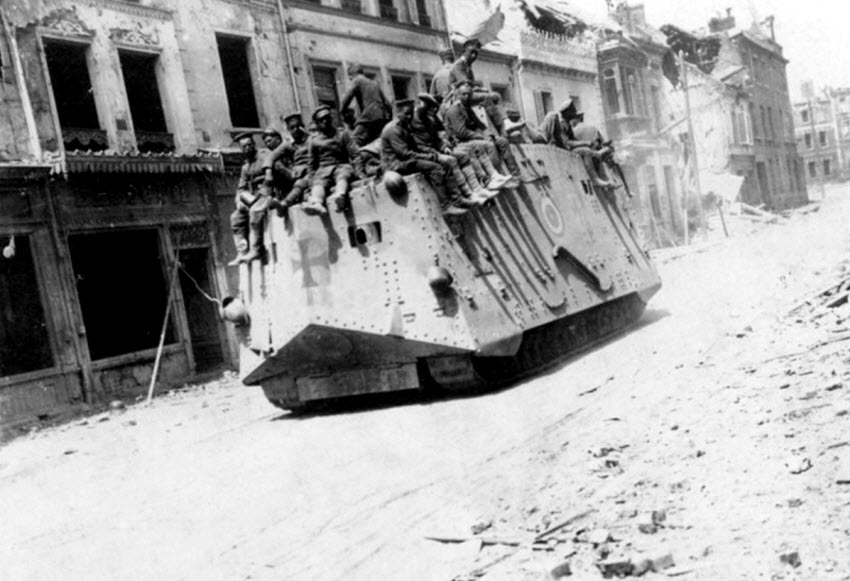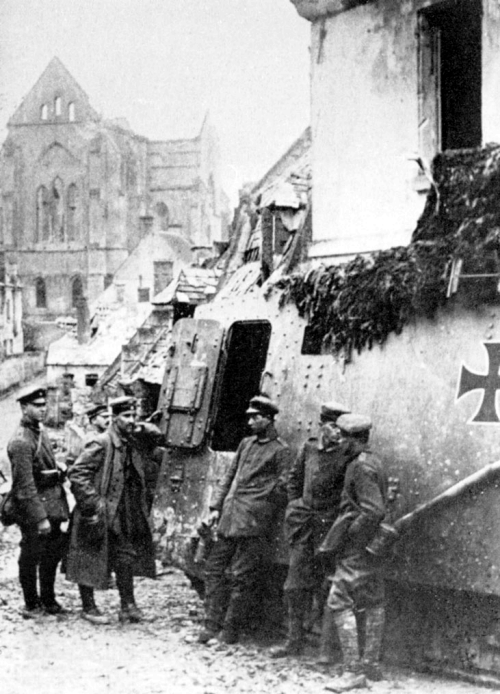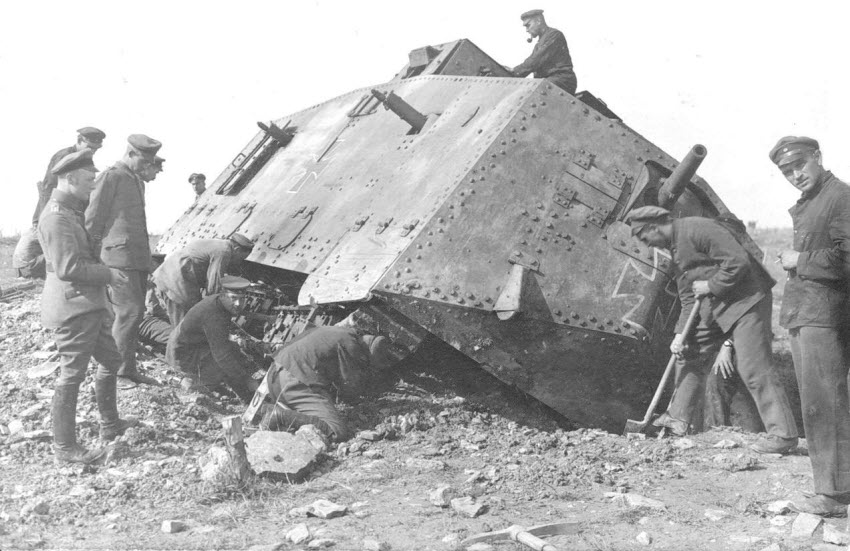|
|||||||||
|
|
German Tanks of World War 1
In contrast to Germany's heavy reliance on tank formations during the Second World War, the Imperial German Army fielded very few tanks during WW1. The German tank program was hastily organized in reaction to the appearance of British and French tanks on the Western Front, and was not very successful. Few tanks were produced and even fewer saw combat. It was a peculiar feature of tank warfare during World War 1 that the tanks produced by both sides were unreliable and tended to break down or get stuck in shell craters and trenches. As a result, both sides frequently captured enemy tanks and were able to incorporate them into their own forces. Due to the small number of German tanks produced, the German armoured forces actually consisted mainly of captured British and French tanks. 
Front View of a German A7 Tank The only German made tank to see combat in World War 1 was the A7 Tank. Its name derived from that of the organization overseeing its development, the Allgemeines Kriegsdepartement, 7. Abteilung, Verkehrswesen ("General War Department, 7th Branch, Transportation"). German soldiers also referred to the A7 as Sturmpanzerwagen, ("armoured assault vehicle"). A total of 100 A7 tanks were ordered but only 20 were completed and delivered to German forces during World War 1. A far larger number of captured British and French tanks fought with the Germans, than their own indigenously produced armor. In comparison to the tiny German tank force, the French produced 3,600 tanks during and the British 2,400 tanks during World War 1. 
German A7 Tank Carrying Troops On Top, Passing Through a Captured French Village During World War 1 The A7 was a fairly large machine 7.34 m (24 ft 1 in) long, 3.1 m (10 ft) wide and 3.3 m (10 ft 10 in) in height. It weighed about 32 tons and had a crew of 18 consisting of an officer, two mechanics, and 15 gunners and ammunition loaders. Its armor was inferior to that of its British and French counterparts because it was not made of hardened steel and therefore was more vulnerable to anti tank fire; it could be pierced by some high caliber machine gun fire. Even worse, the tank was designed in such a way that there was a blind spot 10 meters long directly in front of the driver so that he could not see the terrain where he was going. It would be next to impossible to drive a car down a straight street not being able to see anything within 10 meters in front; imagine trying to navigate a 30 ton tank over extremely rough terrain while under enemy fire. 
German Tank Crew Posing Next to their A7 Tank The A7 came in two varieties: a male and a female. The male version had 6 machine guns and a small 5.7 cm cannon in the front. The female version had no cannon but two extra machine guns in its place. The female variant proved even more unsuccessful than the male version and was retrofitted with a cannon soon after production. Despite the inherent limitations of this German tank design, the A7 saw some success in combat. It took part in a number of engagements, and was used to blunt allied infantry breakthroughs and support German infantry attacks. It also took part in the first tank versus tank battle when a formation of German A7 tanks together with a number of captured British tanks engaged a tank formation of British tanks during the Second Battle of Villers-Bretonneux (April 24-27, 1918). During this battle, which was part of a larger German attack near Amiens, the Germans fielded 14 A7 tanks, almost their entire tank force. The German attack, supported by poison gas and artillery, met with initial success. The German tank squadron broke through the allied lines and captured the village of Villers-Bretonneux, but an allied counter attack supported by British armor retook the village. The action is notable because it was the first tank versus tank battle in history. 
Attempting to Dig Out a German Tank. The Rough Terrain of the Western Front Was the Greatest Enemy of the Tank The German Army realized the design flaws of the A7 and planned to replace it with better tank models. However the war ended before any of the prototypes could be brought into service. At the end of World War 1, the German army was working on the development of several tank designs:
Despite the practical failure of the German tank program, the lessons learned by the Germans in World War 1 would lead to the development of the superb German tank forces in the next war, and they would be employed with stunning success during the invasions of Poland, France and Russia. On the other hand, the British and the French, who had spearheaded the development of the tank failed to learn important lessons in World War 1, and so when the next war came, they were the ones lagging behind the Germans both in material and in tank doctrine. See Also: British Tanks | French Tanks |Italian Tanks | Russian Tanks | ||||||||
